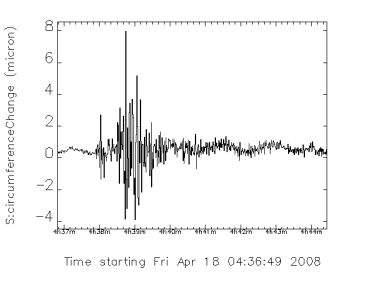The earthquake that occurred in Illinois’ Wabash Valley fault system on Friday, April 18, could have caused a fault of different kind — a system fault that could have interrupted delivery of high-brightness x-ray beams to researchers using the Argonne Advanced Photon Source (APS). But thanks to the sophisticated technology in use at the APS — much of it developed at Argonne — experimenters who were taking data at the APS when the earthquake occurred at 4:36 a.m. (DST) were able to continue their research uninterrupted.
Losing “beam time” (the hours of x-rays allotted to experimenters following acceptance of their research proposal) is not a trivial matter. Each year, thousands of scientists from 50 U.S. states and countries the world over come to the APS to keep their appointments with the x-ray beams. Had the earthquake caused an interruption in the delivery of beam, much valuable research time could have been lost.
The magnitude 5.2 earthquake that shook southern Illinois was “detected” by the beam position monitors that keep the electron beam on course in the APS particle accelerator (see the accompanying figure), but the machine continued to orbit electrons at nearly the speed of light with no noticeable adverse effects. Other monitors (x-ray beam position monitors) assured that x-ray beams illuminated experiment samples as small as molecules.
According to the Associated Press, there were no immediate reports of significant injuries or damage resulting from the quake, which was felt as far away as southern Ontario, Canada. A second, smaller quake, measured at 4.5 on the Richter scale, struck several hours later.
At the APS, the electron beam orbits inside a storage ring (a ring of vacuum chambers and powerful electromagnets) as it produces x radiation for use by researchers. When the tremors from the quake reached the Argonne site, the electron beam remained on course while the entire storage ring shifted back and forth a maximum of 12 microns.
Compensating for Earth (and Moon)-related influences on the APS accelerator complex is fairly routine for Glenn Decker (Diagnostics Group Leader in the Accelerator Systems Division) and the other APS accelerator physicists. “The radio frequency in the accelerator is routinely changed to compensate for Earth tides,” said Decker. “The storage ring moves 37 microns over a roughly 12-hour period as the Moon travels from one side of the Earth to the other.”
The dynamics of movement of the Earth’s surface is more complex for an earthquake than for tidal motion. The tides’ effect on the Earth is akin to the steady expansion and contraction of our lungs as we breathe normally, while the effect of an earthquake can be likened to the shivering brought on by extreme cold.
The APS, which produces the Western Hemisphere’s brightest x-ray beams for research, is funded by the U.S. Department of Energy, Office of Science, Office of Basic energy Sciences.
Argonne National Laboratory brings the world's brightest scientists and engineers together to find exciting and creative new solutions to pressing national problems in science and technology. The nation's first national laboratory, Argonne conducts leading-edge basic and applied scientific research in virtually every scientific discipline. Argonne researchers work closely with researchers from hundreds of companies, universities, and federal, state and municipal agencies to help them solve their specific problems, advance America's scientific leadership and prepare the nation for a better future. With employees from more than 60 nations, Argonne is managed by UChicago Argonne, LLC for the U.S. Department of Energy’s Office of Science.

